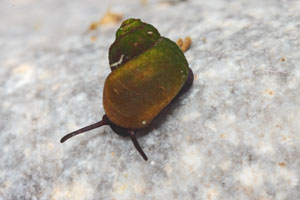
Tradescantia is a genus of 85 species of herbaceous perennial wildflowers in the family Commelinaceae, native to the Americas from southern Canada to northern Argentina, including the West Indies. Members of the genus are known by many common names, including inchplant, wandering jew, spiderwort, and dayflower.

Tradescantia fluminensis is a species of spiderwort native to South America. It is one of several plants known by the common name wandering Jew, but now also commonly called wandering trad. It is also known as small-leaf spiderwort, river spiderwort, inch plant, Speedy Henry, and wandering willie. The genus is named after the English naturalists and explorers John Tradescant the Elder and John Tradescant the Younger (1608–1662).

Thoracochromis is a fish genus of haplochromine cichlids that are endemic to Africa. Most species are from rivers in Angola and Namibia, or the Congo River Basin in Central Africa, but T. wingatii is from the Nile system. Additionally, there are a few apparently undescribed species from the Nile system, which appear to be close relatives of T. wingatii or Haplochromis loati. Many species have been moved between this genus and Haplochromis, and while some consensus has been reached in recent years, their mutual delimitation is still far from settled.

Stiphodon is a genus of freshwater gobies. They inhabit swift, clear streams close to the sea and are found in large parts of Asia and Oceania. Many of the 36 currently recognized species have extremely restricted distributions on single islands or even single streams. These are small gobies with bodies squarish in cross section. A female of Stiphodon multisquamus with a standard length of 60.4mm is the largest Stiphodon individual on record.
José Mariano de Conceição Vellozo (1742–1811) was a Colonial Brazilian botanist who catalogued specimens, for example: Cedrela fissilis Vell. in Florae Fluminensis. He was born in Tiradentes, formerly called São José do Rio das Mortes, state of Minas Gerais; and died in Rio de Janeiro, state of Rio de Janeiro. While at the University of Coimbra in Portugal in the 1790s he worked with Martim Francisco Ribeiro de Andrada in translating works on mineralogy and agriculture. The standard author abbreviation Vell. is used to indicate this person as the author when citing a botanical name.

Loricariinae is a subfamily of the family Loricariidae of catfish. This subfamily is divided into two tribes and about 30 genera. They are mainly native to freshwater habitats in South America, but there are also several species in Panama and a single (Fonchiiichthys) in Costa Rica.
Harttiella is a genus of armored catfishes native to South America.
Harttia is a genus of armored catfishes native to South America.

The Rio de Janeiro antwren is a species of bird in the family Thamnophilidae. It is endemic to Brazil, and is currently thought only to survive in Guapi Açu Ecological Reserve, although identification is tricky and its continued survival has been questioned.

Melanotaenia is a genus of rainbowfish from Australia, Indonesia, New Guinea, and nearby smaller islands.
Harttia depressa is a species of armored catfish endemic to Brazil where it is found in the Uatumã River basin. This species grows to a length of 12.6 centimetres (5.0 in) SL.
Harttia duriventris is a species of armored catfish endemic to Brazil where it is found above the Tucurui Dam in the Tocantins River. This species grows to a length of 12.8 centimetres (5.0 in) SL.
Harttia punctata is a species of armored catfish endemic to Brazil where it is found in the Tocantins River basin. This species grows to a length of 13.3 centimetres (5.2 in) SL.

Hoplias is a genus of fish in the family Erythrinidae found in Central and South America.
Nisiturris fluminensis is a species of sea snail, a marine gastropod mollusk in the family Pyramidellidae, the pyrams and their allies.

Sahitisuchus is an extinct genus of sebecid mesoeucrocodylian known from Rio de Janeiro State of southeastern Brazil. It contains a single species, Sahitisuchus fluminensis. It is a terrestrial sebecid, however also adopted to a semi-aquatic lifestyle to some degree, most probably coexisting with the semi-aquatic alligatorid Eocaiman itaboraiensis.

Sadleriana fluminensis is a land snail from the family Hydrobiidae.
Harttia absaberi is a species of armored catfish where it is found in the upper rio Paraná drainage in Brazil.
Peckoltia capitulata is a species of catfish in the family Loricariidae. It is native to South America, where it occurs in the Approuague River in French Guiana. It was initially collected from an area of the river with a swift, strong current that was noted to be unusually turbid at the time of collection due to illegal gold mining in the area. The species reaches 7.6 cm SL. Its specific epithet, capitulata, is derived from Latin and reportedly refers to the characteristically small head of the species.
Harttia tuna is a species of catfish in the family Loricariidae. It is native to South America, where it occurs in the upper Paru de Oeste River basin in Suriname. The species reaches 17.2 cm in standard length. It is known to be very morphologically similar to the related species Harttia fluminensis. Its specific name, tuna, is derived from the Tiriyó language and roughly translates to "river".








